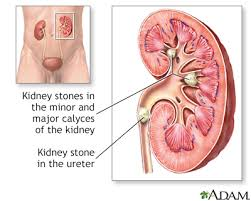A client with chronic bronchitis has a non-productive cough, rhonchi in bilateral lung fields, and difficulty expectorating the secretions. Which intervention should the nurse incorporate into the plan of care?
Place the client on a 35% Venturi mask.
Encourage the client to increase liquid intake throughout the day.
Administer dextromethorphan 30 mg PO every six hours as needed.
Encourage pursed-lip breathing when the client is out of bed.
The Correct Answer is B
Choice a reason:
Placing the client on a 35% Venturi mask would provide a controlled amount of oxygen which is beneficial for clients with chronic obstructive pulmonary disease (COPD) who may retain carbon dioxide. However, this intervention is not directly related to the management of a non-productive cough and difficulty expectorating secretions.
Choice b reason:
Encouraging the client to increase liquid intake throughout the day can help thin the bronchial secretions, making them easier to expectorate. Adequate hydration is essential in the management of chronic bronchitis to help clear mucus from the airways.
Choice c reason:
Administering dextromethorphan, a cough suppressant, may be used to control a non-productive cough. However, it would not assist with the expectoration of secretions and could potentially inhibit the cough reflex needed to clear the airways.
Choice d reason:
Encouraging pursed-lip breathing can help improve ventilation and oxygenation by promoting more effective exhalation. This technique can be beneficial for clients with COPD but does not directly address the issue of expectorating secretions.
Nursing Test Bank
Naxlex Comprehensive Predictor Exams
Related Questions
Correct Answer is C
Explanation
Choice A Reason
Increasing sodium intake is not recommended for patients who have passed a calcium oxalate stone. High sodium intake can increase calcium in the urine, which can contribute to the formation of new stones. Therefore, patients are often advised to limit their sodium intake to reduce the risk of stone recurrence.
Choice B Reason
Considering a move to an area with higher humidity is not a standard recommendation for preventing the recurrence of calcium oxalate stones. While climate can affect hydration levels, it is more important for the patient to focus on direct measures to stay hydrated, such as drinking more fluids.
Choice C Reason
Increasing water intake is a key recommendation for patients who have had calcium oxalate stones. Adequate hydration is essential to dilute the urine, which helps prevent the formation of new stones. Patients are often advised to drink enough water to produce at least 2.5 liters of urine per day.
Choice D Reason
Decreasing the intake of all calcium-rich foods and beverages is not generally recommended for patients with calcium oxalate stones. In fact, a moderate intake of dietary calcium can help reduce the risk of stone formation by binding with oxalate in the intestines, which prevents it from being absorbed into the urine. Patients should consult with a healthcare provider or dietitian to determine the appropriate amount of dietary calcium.

Correct Answer is ["A","B","D","E"]
Explanation
Choice a reason:
Assessing capillary refill and the color of the extremity is essential for determining the vascular status of the limb. A normal capillary refill time is less than 2 seconds and indicates good blood flow. The color should be consistent with the rest of the body, without pallor or cyanosis, which could indicate compromised circulation.
Choice b reason:
Checking pedal pulses is another critical aspect of assessing vascular integrity. The presence of strong and equal pulses in both feet suggests that the blood supply to the lower extremities is not compromised.
Choice c reason:
While the ACE wrap and Velcro boot are part of the postoperative management to provide support and protection to the affected limb, and hanging weights might be used for traction, these are not part of the physiological assessment of the extremity.
Choice d reason:
Monitoring pin sites for signs of infection, such as redness, swelling, or discharge, is crucial in a client with ORIF. Infection can lead to complications that may affect the healing process and the integrity of the fixation.
Choice e reason:
Evaluating the temperature, sensation, and movement of toes helps in assessing for potential nerve damage or compartment syndrome. Any changes in these parameters should be reported immediately as they may signify serious complications.
Whether you are a student looking to ace your exams or a practicing nurse seeking to enhance your expertise , our nursing education contents will empower you with the confidence and competence to make a difference in the lives of patients and become a respected leader in the healthcare field.
Visit Naxlex, invest in your future and unlock endless possibilities with our unparalleled nursing education contents today
Report Wrong Answer on the Current Question
Do you disagree with the answer? If yes, what is your expected answer? Explain.
Kindly be descriptive with the issue you are facing.
